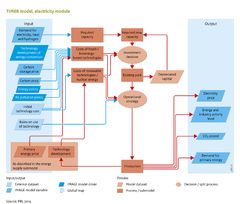Energy conversion: Difference between revisions
Jump to navigation
Jump to search
m (Text replace - "ExternalModel=" to "Model-Database=") |
Oostenrijr (talk | contribs) m (Text replace - "CO2 " to "CO<sub>2</sub>") |
||
| Line 2: | Line 2: | ||
|Application=ADVANCE-WP5 project; Roads from Rio+20 (2012) project; Energy Modelling Forum - EMF; | |Application=ADVANCE-WP5 project; Roads from Rio+20 (2012) project; Energy Modelling Forum - EMF; | ||
|IMAGEComponent=Energy supply and demand; Energy demand; Energy supply; Land-use allocation; Climate policy; Drivers; | |IMAGEComponent=Energy supply and demand; Energy demand; Energy supply; Land-use allocation; Climate policy; Drivers; | ||
|Model-Database=Enerdata Global Energy & | |Model-Database=Enerdata Global Energy & CO<sub>2</sub>Data; IEA database; WEC-Uranium; | ||
|KeyReference=Hoogwijk et al., 2007; Hendriks et al., 2004a; | |KeyReference=Hoogwijk et al., 2007; Hendriks et al., 2004a; | ||
|InputVar=Energy policy; Air pollution policy; Demand for electricity, heat and hydrogen; Primary energy price; Carbon storage price; Carbon price; Technology development of energy conversion; | |InputVar=Energy policy; Air pollution policy; Demand for electricity, heat and hydrogen; Primary energy price; Carbon storage price; Carbon price; Technology development of energy conversion; | ||
|Parameter=Initial technology cost; Rules on use of technology; | |Parameter=Initial technology cost; Rules on use of technology; | ||
|OutputVar=Electricity price; Demand for primary energy; | |OutputVar=Electricity price; Demand for primary energy; CO<sub>2</sub>stored; Energy and industry activity level; | ||
|Description=Energy from primary sources often has to be converted into secondary energy carriers that are more easily accessible for final consumption, for example the production of electricity and hydrogen, oil products from crude oil in refineries, and fuels from biomass. Studies on transitions to more sustainable energy systems also show the importance of these conversions for the future. | |Description=Energy from primary sources often has to be converted into secondary energy carriers that are more easily accessible for final consumption, for example the production of electricity and hydrogen, oil products from crude oil in refineries, and fuels from biomass. Studies on transitions to more sustainable energy systems also show the importance of these conversions for the future. | ||
Revision as of 10:24, 1 July 2014
Parts of Energy conversion
| Component is implemented in: |
|
| Related IMAGE components |
| Projects/Applications |
| Models/Databases |
| Key publications |
Key policy issues
- What is the potential role of energy conversion sector, particularly in power production, in achieving a more sustainable energy system?
- What are the potential roles of individual technologies, such as carbon capture and storage (CCS), nuclear power, hydrogen and renewable energy?
Introduction
<ul><li>Property "HasOutputVar" (as page type) with input value "CO2stored" contains invalid characters or is incomplete and therefore can cause unexpected results during a query or annotation process.</li> <!--br--><li>Property "HasModelDatabase" (as page type) with input value "Enerdata Global Energy & CO2Data" contains invalid characters or is incomplete and therefore can cause unexpected results during a query or annotation process.</li></ul>
